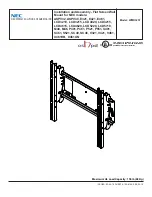
40
• PAL/NTSC demodulation
The 0˚ and 90˚ reference signals from the VCXO are supplied to the HUE phase rotator; it’s outputs (H0, H90) are
supplied to the (B-Y) and (R-Y) burst demodulators respectively.
The demodulated burst from the (B-Y) demodulator supplies NTSC ident information to the ASM(IDN signal).
The demodulated burst from (R-Y) demodulator supplies PAL ident information to the ASM(IDP signal).
For correct demodulation of (R-Y) PAL burst and chroma signals, then the H90 signal requies 180˚ phase shift on
alternate lines. This is realised with the H/2 switch before the (R-Y) demodulator. It is not active during demodulation
of NTSC signals.
The (B-Y)/(R-Y) baseband signals are obtained from the chroma signal by the (B-Y)/(R-Y) demodulators, filtered
and supplied via the PAL/SECAM
SWITCH
(PS) to the internal baseband delay line.
The demodulator gain ratio (B-Y)/(R-Y) is typically 1.78 in order to compensate for scaling in the transmitter.
For NTSC applications it is possible to bypass the delay line via I2C bus command BPS; the gain is also corrected
then by a factor two.
The V
INT
and U
INT
signals from delay line outputs are fed to the YUV selection circuit (see YUV/RGB processing
part).
• SECAM demodulation
SECAM demodulation is realised with a PLL type demodulator.
When the VCXO is connected to pin 35 (controlled by XTS) and if a 4.43MHz Xtal is present on that pin then
SECAM demodulation is possible. The auto tuning loop, consisting of PLL demodualator and oscillator, ensures that
the PLL oscillator is locked to the 4.43MHz Xtal frequency during calibration time in the vertical retrace period. The
SECAM reference voltage, generated at pin 16, is regulated in order that the PLL demodulator output is set to a
reference voltage derived from a stable bandgap voltage.
Outside calibration the oscillator remains tracking the SECAM chrominance resulting in the corresponding
demodulated voltage. This is delivered to the LF de-emphasis stag and to the line ident stage of the Automatic
System Manager (IDS signal). The H/2 switch distributes the demodulated signal to the (R-Y) and (B-Y) amplifiers
and via the PAL/SECAM switch(PS) to the baseband delay line. The bypass mode of the delay line is not possible
for SECAM.
The V
INT
and U
INT
signals from delay line outputs are fed to the YUV selection circuit (see YUV/RGB processing
part).
• ASM (Automatic System Manager)
The ASM is field synchronous; it can identify PAL/NTSC/SECAM colour standards. The different possibilities are
controlled by the I
2
C bus input commands. These input commands are communicated to the ASM via the I
2
C bus.
The I2C bus input commands, also supplied to the ASM via the I2C bus, indicate which Xtals must be connected to
pins 34 and 35. This is exxential for correct calibration of the horizontal oscillator.
The I2C command FCO disables the colour killer in forced modes only and allows maximum colour sensitivity.
For colour identification purposes there is also communication with the ASM and:
- the PAL/NTSC ident circuits (IDP, IDN)
- the SECAM ident (IDS)
- the VCXO via Xtalswitch (XTS)
- the PAL/SECAM switch (PS)
- the R-Y demodulator (H/2)
Summary of Contents for DTR-14D3VG
Page 5: ...3 Circuit Block Diagram...
Page 10: ...8 3 Block Diagram...
Page 66: ...64 1 14D3 Mechanical Exploded View...
Page 67: ...65 2 20D3...
Page 68: ...66 3 21D3...
Page 69: ...67 4 16D3...
Page 70: ...67 Printed Circuit Boards...
Page 71: ...Circuit Schematics CP 490 SCHEMATIC DIAGRAM...
Page 72: ...ENGINEER NOTE...
















































